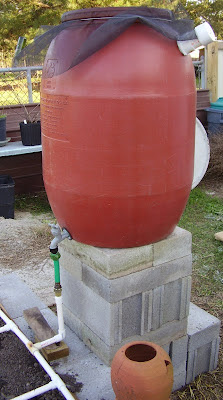lime plaster over papercrete
 Among those who really like our papercrete wall is our cat, Sushi, who has been using it as a scratching post.
Among those who really like our papercrete wall is our cat, Sushi, who has been using it as a scratching post.Cats.
You gotta love 'em.
I've been trying to figure out a way to "finish" the wall--to give it a bit more of a hard shell--and thought lime stucco might be the answer.
Like papercrete, lime is pourous and thus "breathes," absorbing and releasing moisture, etc. from the atmosphere.
Modern paints, as far as I know, wouldn’t do that.
Nor would Portland cement-based "stucco."
I could not find anyone online who has actually put lime plaster over papercrete. So this was a true experiment.
When I first started researching lime it seemed a bit intimidating.
Lime is a "traditional" building material, and some people take that aspect of it very seriously. They seem determined to preserve the "old ways" when it comes to working with lime.
Slaking quicklime, etc.
All very complex and time consuming and more dangerous than working with good ol’ Portland cement, which requires a certain amount of caution, but nothing like quicklime, which, they say, can burn the crap out of you.
Flannery O'Conner's protagonist puts his eyes out with quicklime in the novel Wise Blood.
As it turns out, builder’s lime is pretty much like Portland cement in regards to safety. You want to wear a decent dust mask when working with the powder, and wear rubber gloves. Use common sense, etc.
I bought two 50 pound bags of Type S building lime. Building lime is different from agricultural "lime," which, I understand, is simply powered lime stone. Building lime, also called "hydrated lime," is made from quicklime. Lowes and Home Depot do not carry building lime, at least in my area. I called several building supply houses before I found one that sold it.
It was $12 a bag.
Adding the lime to the water, as instructed, and using an electric drill with a paint mixer bit, I mixed four five gallon buckets of plaster which had the consistency of...cold cream? Sun tan lotion? I didn't actually measure the lime as I added it, but more or less tried to make a "paste" of it. It thickened considerably when I added sand just before use. Though not measuring precisely, I generally used a one to one mixture of sand to plaster. The golden sand turned the stark white lime putty a beautiful beige/coral color.
That lightened a bit as it dried.
Online instructions indicated that lime plaster, once mixed, had to set a couple weeks before use. The instructions on the bag indicated that this particular lime was ready to use as soon as mixed, but because of time constraints it had to set a few days.
I wet the wall well and applied the plaster using some old cds as trowels.
Lime plaster smells more like plaster of Paris than cement. Cement really sort of stinks. Lime smells nice and clean. It was a pleasure to work with.
As is my nature, my experiment involved almost the entire wall.
As the lime plaster dried, I noted one section of hairline cracks. This was a section on which I'd used less aggregate (sand) in my mix, which had made the plaster noticably less gritty during application. Otherwise, the lime plaster seems to have made a nice, very attractive shell over the papercrete.
Time, I suppose, will tell the story.





How has this held up. I am interested in making a papercrete sink with a lime plaster tadelakt over the top.
ReplyDeleteHi did you ever end up making a papercreate sink with tadelekt over it?
Delete